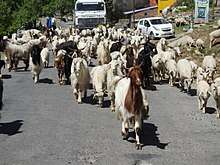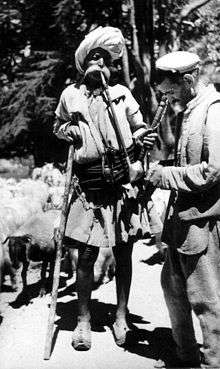Gaddi
The Gaddis are a community living mainly in the Indian states of Himachal Pradesh and Jammu and Kashmir. The term Gaddi is a generic name and under this appellation are included Khatris, Brahmins, Rajputs and Rathis. However, the vast majority are Khatris and the subdivisions of the caste correspond exactly with the tribes among the Khatris existing in the plains of Punjab. They are found mostly in Brahmaur, Pangi tehsils, Holi and Sihunta sub-tehsils of the district Chamba, Himachal Pradesh.[1]


Their poetry and ritual modifications of the plains' Sanscritic tradition reflect their Hindu background. It is believed that the Gaddi community originally belonged to the plains. Due to religious atrocities during the regime of Aurangzeb, the Mughal Emperor, they migrated to Brahmaur. There is a local saying "Ujjaria Lahore te basiya Brahmaur" which means that Brahmaur was populated by persons who escaped from Lahore from the religious persecution.
A brief mention of the Gaddi community in Brahmaur is given here-
Brahmins-They belong to the top-most class and the majority of them have migrated to Brahmaur in the reign of King Meru Varman. They wear the sacred thread and act as priests and purohits. When the capital was shifted: to Chamba, they lost the state patronage and took to other professions. The common gotras of Brahmins are Vashisht, Bhardwaj and Gautam. These gotras are, however, divided into various als which are sometimes incorrectly described as gotras also such as Dharakru Langhe, Phangtain and Sipainu. Brahmins generally marry within their own caste though intercaste marriages with Khatris/Rajputs have been recorded. Unlike the Brahmins of the lower hills, or the plains, the Brahmins of Brahmaur marry into their own gotras also.Thus there is no bar to the solemnisation of a marriage of a' Vashisht boy with a Vashisht girl except that they should not be blood relations. Their mutual form of salutation is namaskar while from others it is pairi pauna to which the reply is asis banchna. The hill Brahmins are, by and large, non-vegetarians and so are the Brahmins of Brahmaur.
Rajputs/Khatris-It is believed that the Rajputs came to Brahmaur as soldiers first with the Brahmaur prince, Raja Jai Stambh. During the Muslim period a large body of Khatris are believed to have migrated to these hills from Lahore. These immigrants started having matrimonial relations with the Rajputs and Brahmins. Rajputs and the Khatris came to be regarded more or less as one caste. It is not uncommon to, find in a family the father calling himself a Rajput and the son styling himself a Khatri. They wear the janeu. The common form of salutation among the Rajputs/Khatris is Jai Jai to one another. They receive it from others and respond with Ram Ram. The occupation of the Rajputs and Khatris is sheep rearing and agriculture and it is they who possess the largest number of sheep and goats, are generally well-off. The Rajputs and Khatris are of Uttam and Bhardwaj gotras, with sub-castes as Kapur, Kondal, Dhanchu, Ranyan, Sahnu and Chauhan. They too generally marry among themselves and also have inter-gotra marital relations leaving aside the blood relations.
It would be wrong to say that the Gaddis fall under the definition of the tribe as such considering their long Hindu Shivaite lineage and traditions which they have kept intact for over more than two thousand years unlike the other tribes of India who still have a different faith or adopted Hinduism only a few hundred years ago. Apart from that, the well-built caste system within the Gaddi community itself is a strong point in case. However, when the government was deciding the formation of Scheduled tribes, it was mentioned that inhabitants of Brahmaur tahsil who call themselves members of a scheduled caste or tribe are entitled to financial benefits such as free education and free medical attention. In the 1931 census, the term Gaddi was disallowed so that there were no Gaddis in Chamba but the proportion of Rajput and allied castes had risen to 72,564. In the 1961 census where Gaddis are regarded as scheduled tribes (but not Brahmins or Rajputs,etc.) the number of Gaddis has suddenly increased. Today due to the climatic adversities of the location and backwardness of the tough Himalayan terrain area, they are considered under the "Scheduled Tribe".
According to the 2011 Census of India, the Gaddi population was 1,78,130 in Himachal Pradesh and 46,489 in Jammu Kashmir. The Gaddis of Himachal Pradesh had an adult sex ratio of 1014 and literacy rate of 73.3, whereas those of Jammu and Kashmir had a sex ratio of 953 and literacy of 53.5. They are classified as a Scheduled Tribe in both areas under India's reservation system.[2]
Over the years Gaddis have been gathering considerable influence in Himachal Pradesh.
Kishan Kapoor, a Gaddi leader is the first to become a Member of Parliament from the community. He was also the first, from the community, to hold a cabinet minister berth in the Government of Himachal Pradesh.
References
- Ibbetson Denzil (1916). Punjab Castes.
- "Statistical Profile of Scheduled Tribes in India" (PDF). Registrar of Census, Government of India. p. 170. Retrieved 1 May 2019.
Further reading
- Report on Schedule Castes and Scheduled Tribes, Part V-B, Vol-XX, Himachal Pradesh, Newell, William. H.
- Ibbetson Denzil, 1916. Punjab Castes
- Verma, V. 1996. Gaddis of Dhauladhar: A Transhumant Tribe of the Himalayas. Indus Publishing Company, New Delhi.
External links
| Wikimedia Commons has media related to Gaddi. |